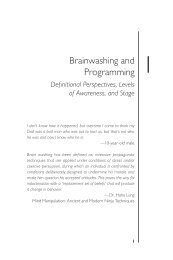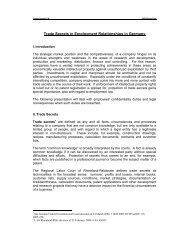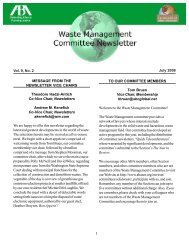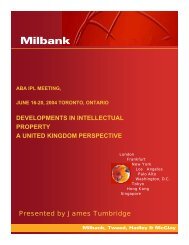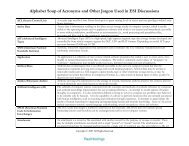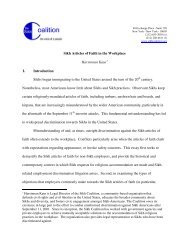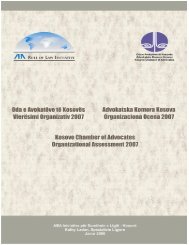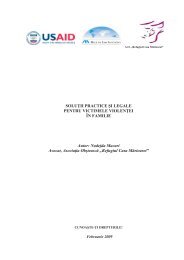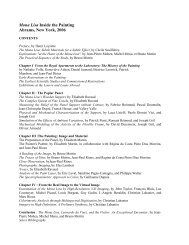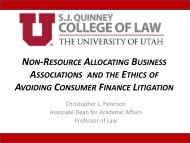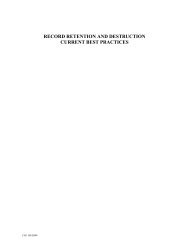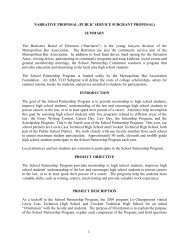Curing Defects in Stock Issuances - American Bar Association
Curing Defects in Stock Issuances - American Bar Association
Curing Defects in Stock Issuances - American Bar Association
Create successful ePaper yourself
Turn your PDF publications into a flip-book with our unique Google optimized e-Paper software.
<strong>Cur<strong>in</strong>g</strong> <strong>Defects</strong> <strong>in</strong> <strong>Stock</strong> <strong>Issuances</strong> Under Delaware Law 1147<br />
* * *<br />
The Delaware Uniform Commercial Code conta<strong>in</strong>s a specifi c provision deal<strong>in</strong>g<br />
with the overissue of stock. In particular, section 210 of the DUCC, titled “Overissue,”<br />
provides, <strong>in</strong> pert<strong>in</strong>ent part, as follows:<br />
(a) In this section, “overissue” means the issue of securities <strong>in</strong> excess of the amount<br />
the issuer has corporate power to issue, but an overissue does not occur if appropriate<br />
action has cured the overissue.<br />
(b) Except as otherwise provided <strong>in</strong> subsections (c) and (d), the provisions of this<br />
Article which validate a security or compel its issue or reissue do not apply to the<br />
extent that the validation, issue, or reissue would result <strong>in</strong> overissue.<br />
(c) If an identical security not constitut<strong>in</strong>g an overissue is reasonably available for<br />
purchase, a person entitled to issue or validation may compel the issuer to purchase<br />
the security and deliver it if certifi cated or register its transfer if uncertifi cated, aga<strong>in</strong>st<br />
surrender of any security certifi cate the person holds.<br />
(d) If a security is not reasonably available for purchase, a person entitled to issue<br />
or validation may recover from the issuer the price the person or the last purchaser<br />
for value paid for it with <strong>in</strong>terest from the date of the person’s demand. 218<br />
No Delaware court has addressed the mean<strong>in</strong>g of “cured” and whether an overissue<br />
of stock can be “cured,” per section 210, by fi l<strong>in</strong>g a certifi cate of amendment<br />
to <strong>in</strong>crease the number of authorized shares of stock (or otherwise). 219 As a matter<br />
of fi rst impression, it would appear that an after-the-fact <strong>in</strong>crease <strong>in</strong> the number<br />
of authorized shares by a certifi cate amendment (or by an amendment to a certifi -<br />
cate of designations where the board has blank check authority) should “cure” an<br />
overissue. 220 Indeed, if a certifi cate amendment cannot “cure” an “overissue,” what<br />
could? Any other view would seem to render the statute mean<strong>in</strong>gless. Arguably, the<br />
statute supersedes the Delaware Supreme Court’s hold<strong>in</strong>g <strong>in</strong> Triplex, at least that<br />
aspect of the hold<strong>in</strong>g that a certifi cate amendment cannot validate stock <strong>in</strong>itially<br />
issued under a defective charter. While the position that a certifi cate amendment<br />
can cure an overissue has not been adopted by any Delaware court, that may be<br />
218. DEL. CODE ANN. tit. 6, § 8-210 (2005) (emphasis added). Aga<strong>in</strong>, there are only a handful of<br />
cases discuss<strong>in</strong>g this and related DUCC provisions. See supra notes 194, 207 & 213; Hughes Developers,<br />
Inc. v. Montgomery, 903 So. 2d 94, 100–02 (Ala. 2004) (suggest<strong>in</strong>g that stock issued <strong>in</strong> excess<br />
of authorized number is ultra vires and void but quot<strong>in</strong>g U.C.C. provision <strong>in</strong> regard to remedies available<br />
to purported stockholder (cit<strong>in</strong>g Crawford v. Tw<strong>in</strong> City Oil Co., 113 So. 61, 63 (Ala. 1927)));<br />
cf. supra notes 38, 39 & 129.<br />
219. Offi cial Comment 1 to U.C.C. section 8-210 provides that an “overissue may be a relatively<br />
m<strong>in</strong>or technical problem that can be cured by appropriate action under govern<strong>in</strong>g corporate law.”<br />
U.C.C. § 8-210 cmt. 1 (2002). In a treatise on the Uniform Commercial Code as it stood prior to the<br />
existence of what is now section 8-210, the author notes that “Article 8 does not permit validation<br />
of ‘<strong>in</strong>valid’ securities . . . when an overissue would result.” 8 LAWRENCE, LAWRENCE’S ANDERSON ON THE<br />
U.C.C., supra note 208, § 8-202:13, at 107. Arguably, the <strong>in</strong>tent of section 210’s “cure” provision was<br />
to change that conclusion.<br />
220. In certa<strong>in</strong> circumstances, particularly where the statutory error arose from a misfi l<strong>in</strong>g, a certifi<br />
cate of correction fi led <strong>in</strong> compliance with section 103 might cure the <strong>in</strong>validity. See DEL. CODE ANN.<br />
tit. 8, § 103(f ) (2001).



